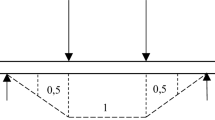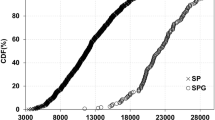Abstract
This paper quantifies the mechanical properties perpendicular to the grain and in shear of glued rotary peeled veneers, as would be encountered in veneer-based structural products (i.e. by including both the effects of hot pressing the veneers and the glue used during the manufacturing process), of three species recovered from juvenile (early to mid-rotation) subtropical hardwood plantation logs. This underutilised resource has currently little to no commercial value in Australia but proven potential to produce attractive veneer-based structural products. Determining these unknown properties is important as they constitute essential input data to ultimately predict the behaviour and design properties of veneer-based structural products in cost-effective numerical simulations. Two species planted for solid timber end-products (Gympie messmate—Eucalyptus cloeziana and spotted gum—Corymbia citriodora) and one species traditionally grown for pulpwood (southern blue gum—Eucalyptus globulus) are considered in the paper. The dynamic modulus of elasticity, compressive and tensile strengths perpendicular to the grain of veneer-based elements, each manufactured from single veneer sheets, were experimentally measured and are analysed herein. These properties are found to have no to weak correlation to the parent veneer sheet dynamic modulus of elasticity parallel to the grain, a value which is commonly measured in line to grade veneers. The shear modulus (in the longitudinal-tangential plane), also referred to as “modulus of rigidity”, through-the-thickness and rolling shear strengths were also experimentally measured, and the results are discussed in the paper. Little to no correlation to the veneer sheet dynamic modulus of elasticity parallel to the grain was found for these properties. Weibull distributions are fitted to all test results and presented to probabilistically consider the investigated properties in numerical simulations of veneer-based structural products.












Similar content being viewed by others
References
Ardalany M, Deam B, Fragiacomo M, Crews KI (2011). “Tension perpendicular to grain strength of wood, Laminated Veneer Lumber (LVL), and Cross-Banded LVL (LVL-C). In: Proceedings of the 21st Australasian conference on the mechanics of structures and materials (ACMSM21), 891–896
AS/NZS 1080.1 (2012) Timber—methods of test—Moisture content. Standards Australia, Sydney, Australia
AS/NZS 2269.1 (2012) Plywood—Structural, part 1: determination of structural properties—test methods. Standards Australia, Sydney, Australia
AS/NZS 4357.2 (2006) Structural laminated veneer lumber, part 2: determination of structural properties—test methods. Standards Australia, Sydney, Australia
ASTM D143-14 (2014) Standard test methods for small clear specimens of timber. ASTM International, Pennsylvania
ASTM D2718-00 (2011) Standard test methods for structural panels in planar shear (Rolling Shear). ASTM International, Pennsylvania
ASTM D2719-13 (2013) Standard test methods for structural panels in shear through-the-thickness. ASTM International, Pennsylvania
ASTM D5456-17e1 (2017) Standard specification for evaluation of structural composite lumber products. ASTM International, Pennsylvania
Australian Government (2017) Australia’s forests at a glance 2017, with data to 2015–16. In: Australian Bureau of Agricultural and Water Resources, ed., Australian Bureau of Agricultural and Water Resources
Boughton GN, Crews KI (2013) Timber design handbook in accordance with the Australian Limit State Design Code AS 1720.1–2010, Standards Australia, Sydney, Australia
Brancheriau L, Bailleres H (2002) Natural vibration analysis of clear wooden beams: a theoretical review. Wood Sci Technol 36:347–365
CIRAD (2012) BING® (Beam Identification by Nondestructive Grading) software. https://www.picotech.com/library/application-note/non-destructive-testing-of-wood. Accessed 25 Sep 2015
Clouston PL, Lam F (2001) Computational modeling of strand-based wood composites. ASCE J Eng Mech 127(8):844–851
EN 1058 (2009) “Wood-based panels—determination of characteristic 5-percentile values and characteristic mean values. The European Union Per Regulation, Brussel
EN 14374 (2004) “Timber structures. Structural laminated veneer lumber requirements. The European Union Per Regulation, Brussel
EN 408 (2010) Timber structures. Structural timber and glued laminated timber. Determination of some physical and mechanical properties. The European Union Per Regulation, Brussel
Gaunt D, Penellum B, McKenzie HM (2002) Eucalyptus nitens laminated veneer lumber structural properties. N Z J For Sci 33(1):114–125
Gibson LJ, Ashby MF (1999) Wood (Chap. 10). In: Clarke DR, Suresh S, Ward IMFRS (eds) Cellular solids—structure and properties, 2nd edn. Cambridge university press, Cambridge
Gilbert BP (2018) Compressive strength prediction of veneer-based structural products. ASCE J Mater Civ Eng. https://doi.org/10.1061/(ASCE)MT.1943-5533.0002417
Gilbert BP, Underhill ID, Bailleres H, El Hanandeh A, McGavin RL (2014) Veneer based composite hollow utility poles manufactured from hardwood plantation thinned trees. Constr Build Mater 66:458–466
Gilbert BP, Bailleres H, Fischer MF, Zhang H, McGavin RL (2017a) Mechanical properties of rotary veneers recovered from early to midrotation subtropical-hardwood plantation logs for veneer-based composite applications. ASCE J Mater Civ Eng 29(10):04017194
Gilbert BP, Bailleres H, Zhang H, McGavin RL (2017b) Strength modelling of laminated veneer lumber (LVL) beams. Constr Build Mater 149:763–777
Gilbert BP, Underhill ID, Fernando D, Bailleres H (2017c) Structural solutions to produce long timber veneer based composite hollow sections. Constr Build Mater 139:81–92
Gilbert BP, Underhill ID, Fernando D, Bailleres H, Miller D (2018) Structural behaviour of hardwood veneer-based circular hollow sections of different compactness. Constr Build Mater 170:557–569
Guitard D, El Amri F (1987) Modèles prévisionnels de comportement élastique tridimensionnel pour les bois feuillus et les bois résineux (in French). Ann For Sci 44(3):335–358
Holmberg S, Persson K, Petersson H (1999) Nonlinear mechanical behaviour and analysis of wood and fibre materials. Comput Struct 72(4–5):459–480
JCSS (2006) JCSS probabilistic model code, part 3: resistance models. JCSS
Kretschmann DE (2010) Mechanical properties of wood (Chap. 5). Wood handbook, wood as an engineering material—Centennial Edition. Forest Products Laboratory—United States Department of Agriculture Forest Service, Madison
Madsen B, Buchanan AH (1986) Size effect in timber explained by a modified weakest link theory. Can J Civ Eng 13:218–232
McGavin RL, Bailleres H, Lane F, Fehrmann J (2013) High value timber composite panels from hardwood plantation thinnings. Project Report DAFF, Department of Agriculture, Fisheries and Forestry (DAFF), Brisbane. http://era.daf.qld.gov.au/id/eprint/4520/
McGavin RL, Bailleres H, Fehrmann J, Ozarska B (2015a) Stiffness and density analysis of rotary veneer recovered from six species of Australian plantation hardwoods. BioResources 10(4):6395–6416
McGavin RL, Bailleres H, Hamilton MG, Blackburn D, Vega M, Ozarska B (2015b) Variation in rotary veneer recovery from Australian plantation Eucalyptus globulus and Eucalyptus nitens. BioRessources 10(1):313–329
Metriguard (2017) Model 2805 DME. https://metriguard.com/product/model-2800-dme. Accessed 30 Jan 2018
Monteiro de Carvalho A, Rocco Lahr FA, Bortoletto GJ (2004) Use of brazilian eucalyptus to produce LVL panels. For Prod J 54(11):61–64
Nolan G, Greaves B, Washusen R, Parsons M, Jennings S (2005) Eucalypt plantations for solid wood products in Australia—a review ‘if you don’t prune it, we can’t use it’. Forest & Wood Products Research & Development Corporation, Melbourne
Pot G, Denaud L-E, Collet R (2015) Numerical study of the influence of veneer lathe checks on the elastic mechanical properties of laminated veneer lumber (LVL) made of beech. Holzforschung 69:337–45
Rahayu I, Denaud L, Marchal R, Darmawan W (2015) Ten new poplar cultivars provide laminated veneer lumber for structural application. Ann For Sci 72(6):705–715
Weibull W (1939) A statistical theory of strength of materials. Generalstabens litografiska anstalts förlag, Stockholm
Acknowledgements
The authors would like to thank the Australian Research Council for its financial support through project DE140100212. The support provided by the Queensland Department of Agriculture and Fisheries (DAF) through the provision of the unique Salisbury Research Facility is also acknowledged. The authors also express their gratitude to the Forest Product Innovation team at the Salisbury Research Facility for their invaluable help in preparing the 3-ply LVL.
Author information
Authors and Affiliations
Corresponding author
Ethics declarations
Conflict of interest
On behalf of all authors, the corresponding author states that there is no conflict of interest.
Additional information
Publisher’s Note
Springer Nature remains neutral with regard to jurisdictional claims in published maps and institutional affiliations.
Electronic supplementary material
Below is the link to the electronic supplementary material which provides the detailed test results.
Rights and permissions
About this article
Cite this article
Gilbert, B.P., Husson, J.M., Bailleres, H. et al. Perpendicular to grain and shear mechanical properties of veneer-based elements glued from single veneer sheets recovered from three species of juvenile subtropical hardwood plantation logs. Eur. J. Wood Prod. 76, 1637–1652 (2018). https://doi.org/10.1007/s00107-018-1350-8
Received:
Published:
Issue Date:
DOI: https://doi.org/10.1007/s00107-018-1350-8




